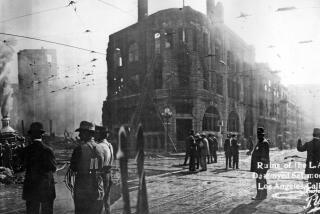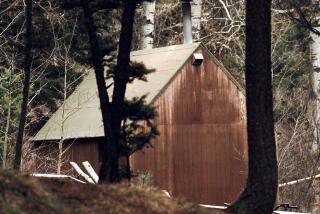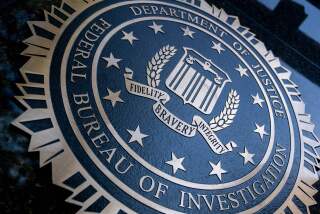Kaczynski Indicted in 4 Unabomber Attacks
- Share via
SACRAMENTO — Eleven weeks after Unabomber suspect Theodore John Kaczynski was arrested at his remote cabin in central Montana, a federal grand jury here indicted him Tuesday in four bombings, including ones that killed a Capitol lobbyist and a local merchant.
Kaczynski, 54, a Harvard University-trained mathematician, was charged with 10 counts of bombing-related offenses, including several that could carry the death penalty in the Sacramento slayings of computer store owner Hugh Scrutton in 1985 and timber lobbyist Gilbert Murray in 1995.
The attacks were part of a coast-to-coast, 17-year reign of violence that prompted one of the most intensive manhunts in U.S. history, with FBI agents investigating thousands of tips that led them from junkyards to universities. The search ended April 3 with Kaczynski’s arrest.
The charges filed Tuesday relate to bombs that were either mailed or exploded in Sacramento. Other crimes attributed to the Unabomber, including a fatal bombing in New Jersey, are still under investigation, the government said.
The indictments triggered strong feelings in Sacramento. “I’m afraid I’ll die before they get rid of him. You can’t deliberately go out and kill three people for no good reason and stay around,” said Scrutton’s mother, Bessie Dudley, 78.
The news also hit home at the office of the California Forestry Assn. Tuesday would have been the 48th birthday of Gilbert Murray, the group’s president. He was killed when he opened a package containing a bomb that exploded.
“I think everyone was relieved that he was captured,” said David Bischel, Murray’s successor. “But we have some mixed feelings about the trial being here in Sacramento. . . . It’s going to be a real emotional disruption of our daily lives and dredge up some of the emotions and trauma from the tragedy itself.”
In addition to the two fatal bombings in Sacramento, Kaczynski was charged with sending two bombs that injured professors at Yale University and UC San Francisco.
Kaczynski has been held in Helena, Mont., since his arrest on charges of possession of bomb-making materials. He is seeking a U.S. Supreme Court ruling on his contention that he should not be prosecuted because of government leaks to the news media.
His lawyer, federal public defender Anthony Gallagher, in Great Falls, Mont., said Tuesday that he had no comment on the indictment. But he added that he is trying to determine when his client might be moved to Sacramento.
The government said Tuesday that it plans to dismiss, for now, the Montana charge to expedite the Sacramento case.
The next step will be for Kaczynski, a brilliant but terribly shy former UC Berkeley math professor, to be flown to California’s capital under tight security for arraignment in U.S. District Court, probably within the next 10 days.
Kaczynski’s own words led authorities to focus on the hermit-like Illinois native. After newspapers published the Unabomber’s 35,000-word manifesto last year, Kaczynski’s younger brother, David, stumbled across old papers of Theodore’s that seemed to parallel the treatise’s themes on the inhumanity of industrial society.
David, a New York social worker, eventually voiced his misgivings about his brother to authorities.
On Tuesday, David Kaczynski’s lawyer, Anthony Bisceglie, said his client would have no comment on his brother’s indictment. But earlier, David Kaczynski told the Washington Post that “my primary interest, all along, was to protect lives.”
David, along with his mother, Wanda Kaczynski, have voiced the hope that if Theodore Kaczynski is convicted, mental illness will serve as his defense to avoid the death penalty.
Over the years, the former college professor had become increasingly isolated from his family, who sent him $17,000--money that investigators believe allowed Kaczynski to finance his series of bombings, according to a lengthy affidavit made public last week and used to obtain a warrant to search his cabin.
Even before they surrounded his tiny, faded red cabin, investigators believed that Theodore Kaczynski was responsible for the bombing spree that killed three people and injured 23 others, carefully crafting homemade pipe bombs, usually in finely whittled wooden containers but also in such ordinary-looking packages as a Phillies cigar box or a book.
Almost from the start of the bombing spree, authorities were baffled that the terrorist used the monogram “FC.” It was first noticed on a piece of a bomb hidden inside a novel mailed to Percy Wood, then president of United Airlines. While the bomber, in letters, said the initials stood for Freedom Club, the FBI believed that FC was really a single male.
The FBI dubbed the suspect the Unabomber because his early targets were universities and airlines.
On Tuesday, in announcing the indictment, U.S. Magistrate Judge John F. Moulds said the case was being brought against Kaczynski, “also known as FC.” Moulds issued a warrant for Kaczynski and said there would be no bail.
Kaczynski is not charged with murder because there is no general charge of murder in federal law. Murder is a federal crime only under special circumstances, such as when the slaying takes place on a federal reservation or in connection with certain narcotics and organized crime offenses.
But the indictment handed up Tuesday allows for capital punishment. A decision whether to seek the death penalty will be made by Atty. Gen. Janet Reno.
On Tuesday, the Justice Department issued a five-page statement accompanying the indictment, apparently keeping it low-key because of sensitivity about the death penalty as well as pretrial publicity.
“These charges,” Reno said, “are the result of a multi-agency investigation by the UNABOM Task Force into a series of bombings that occurred across the United States beginning in 1978.”
The task force, based in San Francisco, is made up of agents from the FBI, Postal Inspection Service, U.S. Treasury’s Bureau of Alcohol, Tobacco and Firearms, and other agencies.
Reno’s unusually bland statement contrasted with her pledge to seek the death penalty in the Oklahoma City bombing case even before any indictments were returned. President Clinton had made the same pledge.
Defense attorneys later challenged Reno’s outspokenness and tried to sue to block the government from seeking the death penalty.
The government’s low-key posture, despite the nature of Kaczynski’s alleged crimes, also reflects caution not to create pretrial publicity issues, government officials said.
Federal authorities said all Unabomber-related crimes remain under investigation, including the death of Thomas J. Mosser, an advertising executive, killed in 1994 in New Jersey.
In spare language, the nine-page indictment focused on four Unabomber-related attacks tied to Sacramento.
The grand jury charged Kaczynski with transporting a bomb or bomb components from Montana to Sacramento in 1985 and placing it at the back entrance of Rentech, Scrutton’s computer rental business. Scrutton moved it, triggering an explosion.
Kaczynski faces the possibility of the death penalty if convicted in Scrutton’s death because there is no statute of limitations on the federal crime of transporting an explosive device with intent to kill.
Dudley, Scrutton’s mother, said she has just one question for Kaczynski: Why did he place a bomb behind her son’s computer rental business in a small shopping center in Sacramento? She said she wonders “whether he picked out my son or whether it was just happenstance?”
Likewise, officials at the timber lobbying group said they hoped that “the unfolding evidence will bring greater insight into why the California Forestry Assn. was a target of the Unabomber’s evil.”
In that case, the grand jury alleged that Kaczynski transported a bomb from Montana to Oakland, and then mailed it to William Dennison, Murray’s predecessor as president of the forestry association.
When the bomb, in a wooden box tightly wrapped in brown paper, was delivered, workers talked about the strange-looking, shoe-box-sized parcel and shook it. They even wondered aloud whether it was a bomb before leaving it for Murray.
One of his co-workers joked nervously, saying, “I’m going back to my office before the bomb goes off.” Within minutes, the package exploded, killing Murray.
The two deadly attacks form the indictment’s bookends.
In between, the grand jury alleged, Kaczynski transported two other bombs from Montana to Sacramento, mailing one to Dr. Charles Epstein in Tiburon, Calif., in June 1993, and another to Dr. David Gelernter in New Haven, Conn., about the same time.
The bombs to the university professors were encased in wooden boxes placed in padded envelopes. UC San Francisco geneticist Epstein lost several fingers when the parcel exploded at his home. Yale professor Gelernter was injured when he opened a package in his office and it exploded. Epstein declined to comment Tuesday. Gelernter could not be reached.
For Sacramento, the Unabomber case promises to be one of the highest-profile trials in the city’s history. On Tuesday, a dozen or more TV trucks were lined up in front of the eight-story federal courthouse, just down the block from the state Capitol.
Gov. Pete Wilson, who in April said that the state stood ready to help local prosecutors pursue the case against Kaczynski, expressed pleasure at the federal indictment and urged the government to seek the death penalty.
“Given the heinous crimes that Mr. Kaczynski is accused of, if he is convicted, Californians would hope and expect that the federal government would seek the most severe penalty against him--the death penalty,” Wilson said.
“I hope that today’s action by the grand jury marks the beginning of the final chapter in the sad and tragic reign of terror plagued upon so many Californians by the Unabomber,” Wilson said.
The case will be tried before U.S. District Judge Garland E. Burrell Jr., who was born nearly 49 years ago on the Fourth of July in South-Central Los Angeles. A high hurdler champion, he reportedly was inspired to focus on academics after reading “The Autobiography of Malcolm X.”
In 1992, Burrell became the first African American federal judge in the 25-year history of the Sacramento-headquartered Eastern District of California, which stretches from Bakersfield to Oregon.
Quin Denvir, recently named as the federal public defender in Sacramento, said he expects to begin assembling a team of lawyers to represent Kaczynski and that he will take an active role in the case.
He previously served as state public defender. More recently, Denvir has handled some high-profile cases, such as former state schools chief Bill Honig’s appeal of his conflict-of-interest conviction.
The six-member prosecution team is being headed by Robert Cleary, the first assistant U.S. attorney in Newark, N.J. Cleary has been working on the case since Mosser’s death in 1994. Colleagues describe the Fordham University Law School graduate as a “cool head” and a team player.
Times staff writer Ronald J. Ostrow in Washington and researchers Janet Lundblad and Paul Singleton contributed to this story.
* UNABOMBER CASE JUDGE: Garland E. Burrell Jr. is described as deliberate. A3
(BEGIN TEXT OF INFOBOX / INFOGRAPHIC)
Case File on the Bombings
Unabomber suspect Theodore J. Kaczynski, 54, was indicted Tuesday in Sacramento on bombing charges in the deaths of two Sacramento businessmen and the maiming of two university professors.
THE VICTIMS
1) Hugh Scrutton. Computer store owner killed Dec. 11, 1985, by a bomb left behind his store in Sacramento.
2) Gilbert Murray. California Forestry Assn. president; killed April 24, 1995, by a mail bomb in his Sacramento office.
3) Charles Epstein. UC San Francisco geneticist; injured when a bomb mailed from Sacramento exploded at his home in Tiburon on June 22, 1993.
4) David Gelernter. Yale University computer science professor; hurt as he opened a bomb--also mailed from Sacramento--in his New Haven, Conn., office on June 24, 1993.
THE TARGETS
The four incidents are among a string of bombings linked to the Unabomber beginning in 1978. Dots show their locations.
THE CHARGES
* 10 counts of illegally transporting, mailing and using bombs, including charges that carry penalties of life in prison or death. Other Unabomber crimes are still under investigation.
Note: Some cities targeted more than once.
Researched by NONA YATES / Los Angeles Times
(BEGIN TEXT OF INFOBOX / INFOGRAPHIC)
NEXT STEP
After a court hearing, Theodore J. Kaczynski is to be moved from a jail in Helena, Mont., to Sacramento. Prosecutors must decide whether to seek the death penalty. Trial before U.S. District Judge Garland E. Burrell is expected to begin in 1997 in Sacramento.
More to Read
Sign up for Essential California
The most important California stories and recommendations in your inbox every morning.
You may occasionally receive promotional content from the Los Angeles Times.










